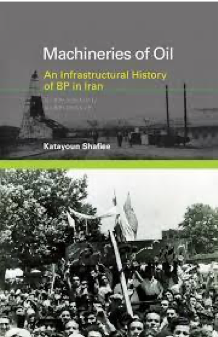
Katayoun Shafiee
Machineries of Oil: An Infrastructural History of BP in Iran
Cambridge, MA: MIT Press, 2018
347 pages
$39.00
Reviewed by Monica Mohseni
In Machineries of Oil: An Infrastructural History of BP in Iran, Katayoun Shafiee uses an amalgamate of Science and Technology Studies, Sociotechnical Systems (both of which are shortened to STS) and Business History to describe how the technicalities of oil extraction shaped Iran’s socio-political development in the first half of the twentieth century. Turning away from the corporate figures and human actors that traditionally monopolize histories of oil, Machineries of Oil focuses on the sociotechnical jargon levied by the British controlled Anglo-Iranian Oil Company (AIOC) on the still developing Iranian state. The AIOC, later renamed British Petroleum, employed formulas and other devices typically used in organizational development as methods of political management to enact their will in the Middle East and assist in the creation of a British International oil consortium.
Distancing herself from earlier corporate-centered oil histories such as Daniel Yergin’s The Prize, Shafiee meaningfully contributes to the conversation held by a suite of scholars, such as Timothy Mitchell, who’ve in the last decade expanded the field of environmental humanities. Scholars like Mitchell, author of Carbon Democracy, have moved beyond traditional historiography—ascribing monumental social, cultural, and political transformative powers to fuel sources. While Shafiee’s argument remains centered around oil, rather than engage with the resource’s overall cultural significance within Iranian and British politics, Shafiee turns to the sociotechnical expertise surrounding the oil industry. Looking at the AIOC’s politicization of the technicalities of the industry, such as mathematical and legal formulas, as well as scientific experiments, the author revisits the historical narrative surrounding Iran’s oil governance, and reveals the ways in which the industry’s over-representation of expertise contributed to the racially-based relationship underpinning British-Iranian politics.
While the book takes much from Mitchell’s work, in particular his drive to circumscribe oil companies with hefty agency, Shafiee’s Machineries of Oil suffers from the same issue that often problematizes environmental humanities. As Allan Stoekl and even Stephanie LeMenager have argued, despite being addressed almost explicitly as a resource and a commodity in academic scholarship, oil remains largely invisible as an economic driver and political actor. Despite its unalienable connection to technology, scholarship surrounding oil has fallen short of recognizing the resource’s “cultural centrality” as Stoekl puts it in his preface to Oil Culture.
Evidently in writing Machineries of Oil Shafiee looks to present an infrastructural rather than a cultural history of oil. However further discussion on the cultural ramifications and limitations of oil would not be amiss when depicting the machinations of an inherently transnational industry, particularly one with such a rich history of imperialism and neo-colonialism. To its credit, chapter four of the book touches upon the socio-cultural outcomes the industry and its main commodity had on its workers. The chapter addresses oil’s role in determining the potential of worker unionization, as well as the AIOC’s racially premised housing organizations and employee formulations, which not only evidence the company’s paternalism but also its racially-based hiring practices and prejudices. Despite the lack of overall attention towards the cultural histories of oil, the text’s overview of the inventive paternalistic measures and practices employed by the AIOC raises further interrogatives that invite future scholarship.
Shafiee’s chosen historiographical approach eschews deeper engagement with the cultural and social effects of oil as a commodity in favor of a novel interdisciplinary framework that combines Sociotechnical Theory, Business History, Material and Technical Politics, and Middle Eastern Studies. Machineries of Oil looks to the study of oil infrastructure not so much to calculate the resource’s political and economic impact in the region, but rather to glean the “sociotechnical process of simplification” by which the British industry wove durable associations between politics and markets. Shafiee looks at the formulas used by BP to strengthen their position in the middle east and their position as an international conglomerate. While the book sufficiently analyzes the industry’s infrastructural effects on Iranian oil governance, further discussion on the politics underpinning the intercultural relationships formed and affected by the sociotechnical system would have strengthened the book’s argument and provided a more solid understanding of the circumstances surrounding the Iranian oil industry.
This being said, scholars hoping to gain further insight into the political and organizational tools employed by the British oil industry in Iran will gain a wealth of information on the AIOC’s history and infrastructural transformation of Khuzistan. Each chapter in the book addresses key moments in the history of Anglo-Iranian oil through various approaches, such as property rights, the monopolization of scientific knowledge and technical expertise, racially-based hiring practices, and sociotechnical arrangements intended to curb nationalism and retain British power. Machineries of Oil contributes to the expanding interdisciplinarity of the humanities, and further broadens the boundaries of what can be expected from future oil histories.


